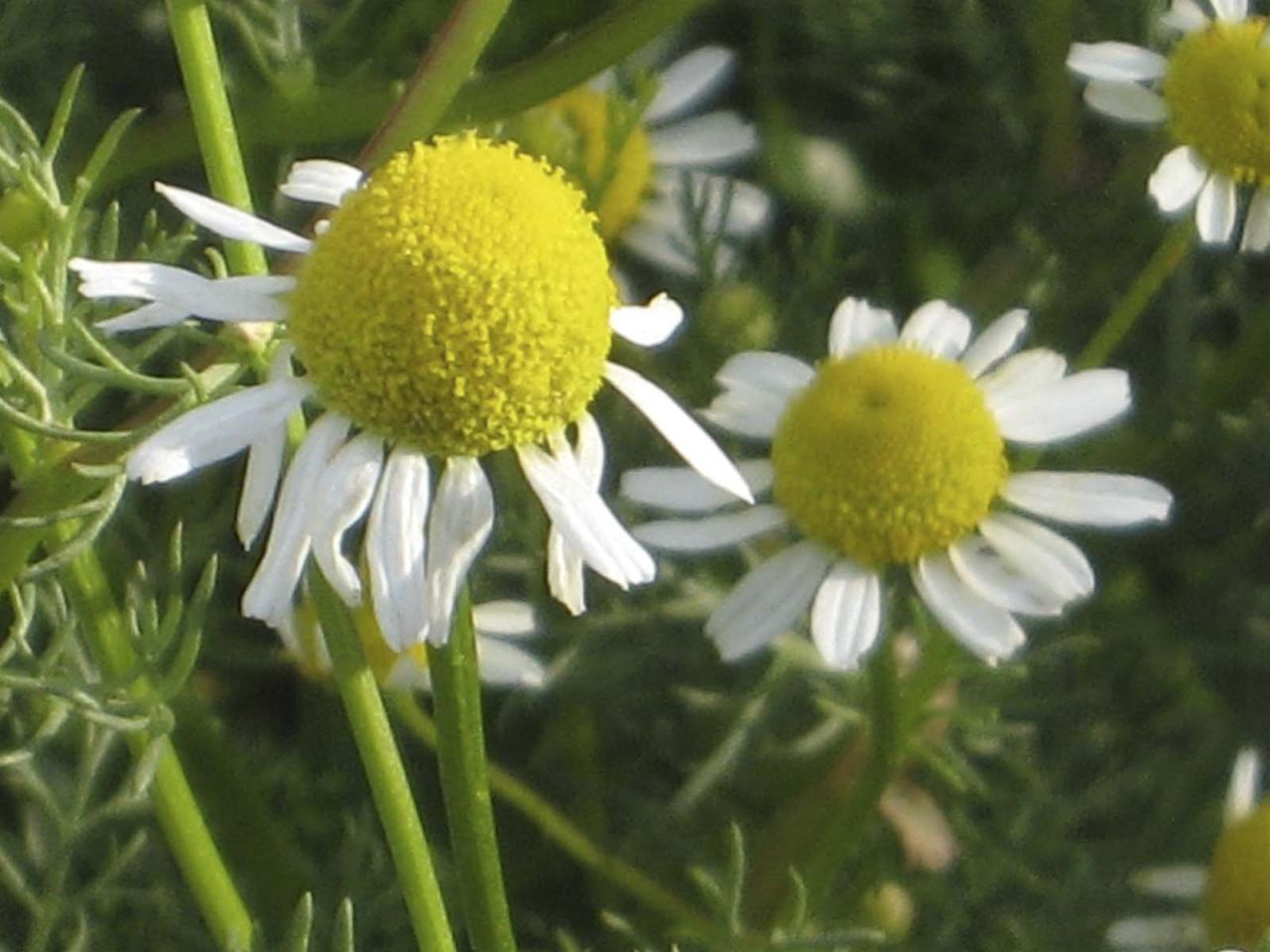How to Grow a Chamomile Lawn in a Raised Bed: Imagine a lush, fragrant carpet of chamomile flowers replacing your traditional grass lawn. This captivating alternative offers a beautiful and aromatic landscape while providing numerous benefits. Chamomile lawns are not only visually appealing but also attract beneficial insects, provide natural pest control, and create a calming atmosphere.
Growing chamomile in a raised bed offers several advantages, including better drainage, improved soil control, and easier access for maintenance. This guide will walk you through the process of creating and nurturing your own chamomile lawn in a raised bed, from selecting the right variety to harvesting the fragrant flowers.
Chamomile lawns are a delightful alternative to traditional grass lawns, offering a soft, fragrant groundcover with numerous benefits. They are perfect for those seeking a low-maintenance, visually appealing, and naturally aromatic landscape. A raised bed provides the ideal environment for chamomile growth, allowing for better control over soil quality and drainage.
This guide will cover every aspect of establishing and maintaining a chamomile lawn in a raised bed, ensuring a successful and fragrant addition to your garden.
Introduction to Chamomile Lawns
Chamomile lawns are a beautiful and fragrant alternative to traditional grass lawns. They are made up of low-growing chamomile plants, which produce delicate white flowers and have a sweet, calming scent. These lawns offer numerous benefits, making them a popular choice for eco-conscious gardeners.A raised bed is an ideal environment for growing chamomile lawns.
It allows you to control the soil composition, ensuring optimal growing conditions for the chamomile plants. Raised beds also provide better drainage, preventing waterlogging and promoting healthy root growth.
Advantages of Chamomile Lawns
Chamomile lawns offer several advantages over traditional grass lawns. They are low-maintenance, drought-tolerant, and attract beneficial insects, contributing to a healthy ecosystem.
- Low Maintenance: Chamomile lawns require less mowing than traditional grass lawns. The plants grow slowly and have a naturally low-growing habit, reducing the need for frequent trimming.
- Drought Tolerance: Chamomile is a drought-tolerant plant, making it a suitable choice for areas with limited water resources. Its deep roots allow it to access moisture from deeper soil layers, making it more resilient to dry conditions.
- Attracts Beneficial Insects: Chamomile flowers attract beneficial insects such as bees and ladybugs, which help to control pests and promote pollination in your garden.
- Soft and Fragrant: Chamomile lawns are soft and comfortable to walk on, providing a pleasant experience for barefoot walking. The flowers also release a calming and soothing aroma, creating a relaxing atmosphere in your garden.
Selecting the Right Chamomile Variety
Choosing the right chamomile variety is crucial for a successful lawn. Both German chamomile (Matricaria recutita) and Roman chamomile (Chamaemelum nobile) are commonly used for lawns, each with distinct characteristics.
German Chamomile vs. Roman Chamomile
Understanding the differences between German chamomile and Roman chamomile is essential for making the right choice for your raised bed lawn.
- Growth Habit:German chamomile is an annual, meaning it completes its life cycle in one year. It grows upright, reaching heights of 1 to 2 feet. Roman chamomile, on the other hand, is a perennial, meaning it lives for multiple years.
It has a spreading growth habit, forming a dense mat of foliage.
- Flowering:German chamomile produces daisy-like flowers with a yellow center and white petals. These flowers are larger and more prominent than those of Roman chamomile. Roman chamomile flowers are smaller and have a yellow center with white petals that are often tinged with pink.
- Fragrance:Both varieties possess a distinct, sweet, and slightly apple-like aroma. However, German chamomile is known for its stronger and more pungent fragrance.
- Hardiness:German chamomile is generally more tolerant of colder climates than Roman chamomile. Roman chamomile thrives in warmer regions and can tolerate mild frosts.
- Maintenance:German chamomile requires regular mowing to maintain its height and prevent it from becoming too tall. Roman chamomile, with its spreading habit, needs less frequent mowing.
Planning Your Chamomile Lawn
Before you start building your raised bed and planting chamomile, it’s crucial to carefully plan the location and design of your chamomile lawn. This includes considering factors like sunlight exposure, soil type, and the desired size and shape of your raised bed.
Sunlight Requirements
Chamomile thrives in full sun, requiring at least 6 hours of direct sunlight daily. Choose a location in your yard that receives ample sunlight throughout the day. If you live in a region with intense summer heat, a spot that receives some afternoon shade can be beneficial to prevent the chamomile from wilting.
Soil Type and pH
Chamomile prefers well-drained, slightly acidic to neutral soil with a pH range of 6.0 to 7.0. It can tolerate a slightly alkaline soil, but it’s best to aim for a slightly acidic environment.
- Testing Your Soil:Before planting, test your soil’s pH using a home soil test kit. These kits are readily available at garden centers and online.
- Adjusting Soil pH:If your soil is too alkaline, you can adjust the pH by adding organic matter like compost or peat moss. If your soil is too acidic, you can add lime to raise the pH.
Raised Bed Size and Shape
The size and shape of your raised bed will depend on your space and personal preference. However, here are some factors to consider:
- Space Availability:Consider the available space in your yard and how much area you want to dedicate to your chamomile lawn.
- Ease of Access:Choose a size that allows you to easily reach all parts of the bed for maintenance and harvesting.
- Aesthetics:Consider the shape and size that best complements your existing landscaping.
Building the Raised Bed
A raised bed provides a controlled environment for your chamomile lawn, allowing you to customize the soil and drainage. It also makes it easier to manage weeds and pests.
Choosing the Right Materials
The material you choose for your raised bed will determine its longevity and aesthetic appeal.
- Wood: Wood is a natural and readily available material. Cedar, redwood, and pressure-treated lumber are good choices due to their durability and resistance to rot.
- Stone: Stone offers a more permanent and rustic look. Options include flagstone, pavers, or even recycled concrete blocks.
- Metal: Metal raised beds are durable and long-lasting, but they can be more expensive. Galvanized steel or aluminum are popular choices.
- Plastic: Plastic raised beds are lightweight and affordable, but they may not be as durable as other materials.
Designing the Raised Bed
Consider the following factors when designing your raised bed:
- Size: The size of your raised bed will depend on the space you have available and the amount of chamomile you want to grow. A bed measuring 4 feet by 8 feet is a good starting point.
- Height: The height of your raised bed will determine how much soil you need. A height of 12 to 18 inches is ideal for chamomile.
- Shape: Raised beds can be rectangular, square, or even circular. The shape will depend on your personal preference and the available space.
Building the Raised Bed
- Prepare the Area: Clear the area where you want to build your raised bed of any debris or weeds. Level the ground to ensure a stable base.
- Assemble the Frame: If using wood, cut the boards to the desired length and width. Join them together using screws or nails. If using stone, use mortar to create a stable structure.
- Line the Bed: Line the inside of the bed with landscape fabric or a similar material to prevent weeds from growing through.
- Fill with Soil: Fill the raised bed with a well-draining soil mix that is rich in organic matter. Chamomile thrives in slightly acidic soil with a pH of 6.0 to 7.0.
Visual Representations of Raised Bed Designs
- Rectangular Wooden Raised Bed: Imagine a classic wooden box structure, with boards joined together to form a rectangular frame. The bed sits on the ground, raised above the surrounding soil.
- Stone Raised Bed with Curved Edges: Envision a bed constructed from natural stones, forming a rounded shape. The stones are carefully arranged and secured with mortar, creating a rustic and durable structure.
- Metal Raised Bed with a Lattice Top: Picture a raised bed made from galvanized steel panels. The top is adorned with a latticework design, adding a decorative element while allowing sunlight to reach the chamomile plants.
Preparing the Soil

Chamomile thrives in well-drained, fertile soil with a slightly acidic to neutral pH. Preparing the soil in your raised bed is crucial for establishing a healthy and flourishing chamomile lawn.
Amending the Soil
Enhancing the soil’s structure and nutrient content is essential for chamomile growth. Adding compost and other organic matter improves drainage, aeration, and provides vital nutrients.
Creating a chamomile lawn in a raised bed offers a controlled environment, allowing you to amend the soil with rich compost for optimal growth. However, if your garden is plagued with rocky soil, don’t despair! You can still enjoy the soft, fragrant blooms of a chamomile lawn by following the tips outlined in How to Grow a Chamomile Lawn in Rocky Soil.
Once you’ve mastered the techniques for rocky soil, you can easily apply them to your raised bed, ensuring a thriving chamomile lawn in any environment.
- Compost: Incorporate a generous layer of well-rotted compost into the existing soil. Compost improves soil structure, water retention, and provides a rich source of nutrients.
- Manure: Aged manure can also be used to amend the soil. It adds organic matter and nutrients, but it’s crucial to ensure it’s well-decomposed to avoid burning the chamomile seedlings.
- Other Organic Matter: Adding materials like shredded leaves, peat moss, or coco coir can improve soil structure and water retention.
Drainage and Aeration
Proper drainage and aeration are vital for chamomile growth. Chamomile roots need access to air and cannot tolerate waterlogged conditions.
- Drainage: Ensure the raised bed has adequate drainage to prevent water from pooling. If necessary, add a layer of gravel or drainage stones to the bottom of the bed.
- Aeration: Regularly loosen the soil in the raised bed to improve aeration. This allows for better root growth and prevents compaction.
Planting Chamomile Seeds

Planting chamomile seeds is a straightforward process, but a few key steps will help ensure successful germination and a thriving lawn. This section will provide a comprehensive guide to planting chamomile seeds in your raised bed.
Timing of Planting
The optimal time for planting chamomile seeds is in the spring or early fall. Spring planting allows the seeds to establish themselves before the summer heat arrives. Fall planting, on the other hand, gives the seeds a chance to root before winter and emerge in the spring.
The exact timing will depend on your local climate and frost dates.
Spacing and Depth
Chamomile seeds are tiny, and proper spacing is crucial for healthy growth.
- Sow the seeds thinly, about 1/4 inch (6 mm) deep, and 6-8 inches (15-20 cm) apart. This spacing allows for adequate airflow and sunlight penetration, which is essential for healthy growth.
- For a more uniform lawn, you can use a seed spreader or broadcast the seeds by hand. Scatter the seeds evenly over the prepared soil surface.
- After sowing, gently press the seeds into the soil, ensuring good contact with the soil for better germination.
Caring for Your Chamomile Lawn: How To Grow A Chamomile Lawn In A Raised Bed

Once your chamomile lawn is established, it’s crucial to provide ongoing care to ensure its health and longevity. Regular watering, fertilizing, weeding, and trimming are essential practices that contribute to a thriving chamomile lawn.
Watering and Fertilizing
Proper watering and fertilization are crucial for maintaining a healthy chamomile lawn. Chamomile prefers well-drained soil that is consistently moist but not waterlogged.
Watering |
Fertilizing |
|---|---|
Water deeply but infrequently, allowing the soil to dry slightly between waterings. |
Use a balanced, organic fertilizer formulated for lawns, following the manufacturer’s instructions. |
During dry spells, increase watering frequency. |
Avoid over-fertilizing, as it can lead to excessive growth and a decline in chamomile’s essential oil production. |
Chamomile is relatively drought-tolerant once established. |
Apply fertilizer in the early spring and late summer. |
Weeding and Pest Control, How to Grow a Chamomile Lawn in a Raised Bed
Regular weeding is essential to prevent unwanted plants from competing with your chamomile for nutrients and sunlight.
- Hand-pull weeds regularly, ensuring to remove the entire root system to prevent regrowth.
- Use a mulch layer to suppress weed growth and retain soil moisture.
- Chamomile is generally pest-resistant, but occasional infestations may occur.
- Identify and remove pests manually, or use organic pest control methods if necessary.
Mowing or Trimming
Chamomile lawns do not require frequent mowing, as they are low-growing plants.
Growing a chamomile lawn in a raised bed offers a unique and fragrant addition to your garden. Once established, the lawn requires regular maintenance to thrive, and this includes mowing. To ensure your chamomile lawn stays healthy and lush, check out How to Mow and Maintain a Chamomile Lawn for detailed instructions.
This guide will provide valuable tips for maintaining the ideal height and shape for your chamomile lawn, ensuring a beautiful and fragrant addition to your raised bed.
- Trim the lawn lightly every few weeks to maintain a desired height and encourage a lush, even appearance.
- Use a sharp, hand-held mower or a pair of shears for trimming.
- Avoid mowing too low, as this can damage the plant and reduce its ability to produce flowers.
- Remove clippings to prevent them from smothering the lawn.
Harvesting and Using Chamomile
Once your chamomile lawn is established and flourishing, you can start harvesting the beautiful, fragrant flowers for a variety of uses. Harvesting chamomile is a simple process, and the flowers can be used to make soothing teas, calming aromatherapy blends, and even as a natural remedy for various ailments.
Harvesting Chamomile Flowers
When harvesting chamomile flowers, it’s important to pick them at the peak of their bloom. This is when the flowers are fully open and have a strong aroma. Here’s a simple guide for harvesting:
- Timing:Harvest the flowers in the morning, after the dew has dried, but before the sun becomes too hot.
- Method:Gently snip the flower heads just above the leaves, leaving a small stem attached. Avoid pulling the flowers, as this can damage the plant.
- Quantity:Harvest only a small amount of flowers at a time to allow the plant to continue growing and blooming.
Drying and Storing Chamomile Flowers
After harvesting, the flowers need to be dried to preserve their aroma and potency. Here are some popular drying methods:
- Air Drying:Spread the flowers in a single layer on a screen or tray in a dry, well-ventilated area. Avoid direct sunlight, as it can bleach the flowers. Turn the flowers occasionally to ensure even drying.
- Dehydrator:Use a food dehydrator set to a low temperature (around 95°F or 35°C). Drying time will vary depending on the dehydrator and the humidity level.
- Microwave:This method is faster but requires careful monitoring. Place a thin layer of flowers on a microwave-safe plate, cover with a paper towel, and microwave in short bursts (10-15 seconds) until dry. Check frequently to avoid burning.
Once dried, store the flowers in airtight containers in a cool, dark place. Properly dried chamomile flowers can retain their potency for up to a year.
Benefits and Uses of Chamomile
Chamomile has been used for centuries for its medicinal properties. It contains compounds like apigenin and bisabolol, which are known for their calming and anti-inflammatory effects. Here are some common uses of chamomile:
- Tea:Chamomile tea is a popular beverage known for its soothing and relaxing effects. It can be used to aid sleep, reduce anxiety, and ease digestive discomfort.
- Aromatherapy:Chamomile essential oil is used in aromatherapy to promote relaxation, reduce stress, and alleviate anxiety. It can be diffused, added to bathwater, or used in massage oils.
- Herbal Remedies:Chamomile is used in herbal remedies to treat a variety of ailments, including insomnia, anxiety, digestive issues, and skin irritations.
Note:While chamomile is generally safe for most people, it’s always best to consult with a healthcare professional before using it for medicinal purposes, especially if you are pregnant, breastfeeding, or have any underlying medical conditions.
Epilogue
Creating a chamomile lawn in a raised bed is a rewarding endeavor that transforms your outdoor space into a fragrant oasis. By following these steps, you can enjoy the beauty, benefits, and calming aroma of chamomile year after year.
Remember to choose the right variety, prepare the soil properly, and provide adequate care. With a little effort, you’ll be rewarded with a lush, fragrant lawn that attracts pollinators, repels pests, and adds a touch of natural beauty to your garden.
So, embrace the world of chamomile lawns and experience the tranquility they bring to your home.
Clarifying Questions
Can I use chamomile lawn for pets?
Chamomile is generally safe for pets, but it’s best to supervise them and ensure they don’t ingest excessive amounts. Some pets may be sensitive to chamomile, so it’s always a good idea to consult your veterinarian.
How often should I mow my chamomile lawn?
Chamomile lawns don’t require frequent mowing. Mow or trim them when they become too tall, typically every 4-6 weeks, to maintain their desired height.
What are some other uses for chamomile flowers?
Chamomile flowers are widely used for making tea, aromatherapy, and herbal remedies. They possess calming and soothing properties, making them beneficial for relaxation and stress relief.

